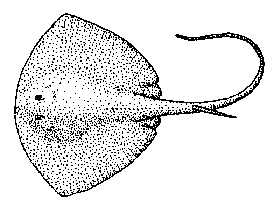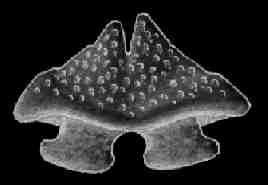EXTANT BATOIDS
DASYATIDAE -- Dasyatis violacea
Jim Bourdon, Scott Greenwald and Henry Mollet
Illustrated by Jim Bourdon, Copyright © 1997
Background
In January 1997, an informal project was spawned, quite by accident (heard that
before?). The seeds were sown so-to-speak during e-mail conversations between Henry Mollet,
volunteer at the Monterey Bay Aquarium (MBA) and Jim Bourdon (currently researching Miocene batoids).
The original question was:
"Is D. violacea represented in the Lee Creek fauna?" Unable to obtain a dentition for
comparative purposes, Scotty Greenwald, an aquarist at the Monterey Bay Aquarium reclaimed
shed teeth teeth from the bottom of a tank with pelagic stingrays.
This first step generated many interesting e-mail conversations, thoughts and questions. Many of the questions
seemed unanswered in available publications. It was apparent that certain questions might be answered
if this material was monitored over a one year period. This webpage is intended for the informal use of
those participating in this project as a bulletin board. The questions, all relating to D. violacea, to be
addressed include:
- What are the shed rates of D. violacea teeth, and do they vary seasonally?
- What do teeth look like, and are there recognizable differences between the sexes?
- Do the male teeth change during breeding season?
- Are there shed rates associated with dermal thorns?
This is a small (to 80 cm/32 inches disc width) pelagic ray of
worldwide distribution in tropical and temperate waters. It feeds on squid, herring, mackerel,
octopus, and crustaceans. The disc is trapezoidal in shape, purple in color and
bears thorns on the back and tail.
 |
Table of Contents
|
A Fossil Record?
Returning to the seed for this project, an attempt will be made to determine if D. violacea appears in the
fossil record, particularly in the Neogene fauna of Lee Creek.
Lee Creek. The phosphate mine at Aurora provides two excellent views into the past. The Pungo
River foramation, reflects Miocene subtropical and the Yorktown, Pliocene warm temperate. Jim Bourdon has
collected nearly a thousand stingray teeth from the mine, most from the Pungo River. The above description of
D. violacea teeth does not "ring any bells" and it will require a full review of the Lee Creek material to determine
if they are, in fact, not present.
Shark Tooth Hill Bone Bed. Gordon Hubbell recently provided hundreds of stingray teeth from this
Middle Miocene site in Kern County, California. Although at least two distinct tooth designs were present,
neither showed any similarity to the D. violacea morphology.
Needed Help!
Any one that would like to assist with this project is welcome. The below items are currently needed:
- Any references to fossil D. violacea specimens in the paleontological literature.
- A male and female D. violacea dentition .
- References to bi-cuspidate teeth in stingrays, particularly relating to D. violacea.
To participate, tender suggestions or whatever, contact one of us:
Jim Bourdon
Scott Greenwald
Henry Mollet
Wallpaper
If you'd like to use the below image as wallpaper, please feel free to grab a copy
.
Page added February 16, 1997, last modified April 20, 1997


